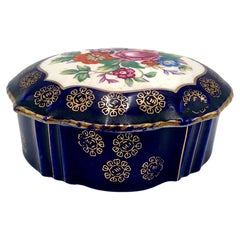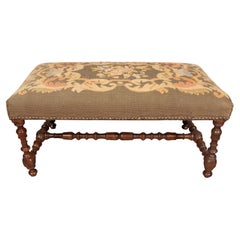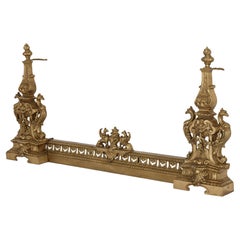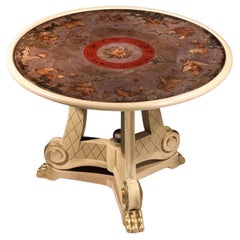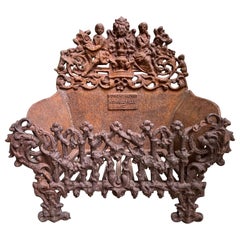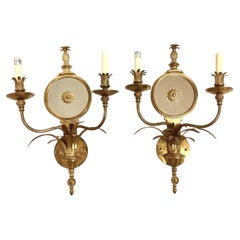French Furniture
to
165
407
339
752
7
4
17,620
13,114
7,366
5,832
5,182
3,355
3,164
2,706
1,388
1,110
875
763
600
474
354
295
212
66
256
282
214
11
105
65
18
23
2
28
11
10
14
10
2
5
2
354
284
115
114
110
5,633
2,440
763
564
414
763
762
763
3
2
2
2
2
Style: Baroque
Place of Origin: French
Porcelain Cobalt Blue Casket with Flowers Scene
Located in Chorzów, PL
Cobalt porcelain casket
Very good condition, no damage.
Casket signed import
Measures: height 5 cm width 11 cm depth 9.5 cm.
Category
1960s Baroque Vintage French Furniture
Materials
Porcelain
Flemish Baroque Walnut Bench
Located in Essex, MA
Rectangular top upholstered in old needlepoint that needs replacement. Turned legs and stretchers.
Category
Early 1700s Baroque Antique French Furniture
Materials
Walnut
Baroque Style Pierced Brass Hearth Fender
Located in London, GB
Baroque style pierced brass hearth fender
French, 19th century
Measures: Height 56cm, width when open 120cm, width when closed 86cm, depth 13cm
This...
Category
19th Century Baroque Antique French Furniture
Materials
Brass
glass table and pedestal table from the 40's attributed to Maison Jansen
By Maison Jansen
Located in Ternay, Auvergne-Rhône-Alpes
Pedestal table from the 40's, attributed to Maison Jansen, work in the taste of Robert Pansard. Painted and carved solid wood table top, superb eglomized glass top representing the s...
Category
1940s Baroque Vintage French Furniture
Materials
Art Glass, Wood
Petite Antique French Cast Iron Planter Jardinière Basket Grate Corneau c1880
By Alfred Corneau
Located in Shreveport, LA
Petite Antique French Cast Iron Planter Jardinière Basket Grate Corneau c1880.
Direct from France, a unique find from our last shipment, a petite and quite heavy cast iron planter, ...
Category
1880s Baroque Antique French Furniture
Materials
Iron
Pair of Gilt Bronze Pineapple Wall Sconces with Mirrors
Located in Bradenton, FL
Pair of 20th Century French Gilt Bronze Wall Sconces with Round Antique Mirrors. Each sconce features two curved arms designed to hold candle-style bulbs, which can illuminate a room...
Category
20th Century Baroque French Furniture
Materials
Metal, Bronze
Early 18th Century Leather and Linnen French Wingchair
Located in Vosselaar, BE
A early 18th century walnut French wingback armchair. This Louis XIV model is also known as Os de Mouton or 'Sheepclaw feet'. The shape of the feet were a provincial take on the gild...
Category
Early 18th Century Baroque Antique French Furniture
Materials
Leather, Walnut
19th Century French Hand Painted Red, Blue and Green Stained Glass Church Panel
Located in Hastings, GB
Antique stained glass church panel French in origin exact age unknown, mid to late 19th century.
Beautiful hand painted designs across the vib...
Category
Mid-19th Century Baroque Antique French Furniture
Materials
Stained Glass
Antique 18th century Ceramic/Porcelain Pair of Cockfighting Roosters Paris 1780
Located in Doha, QA
One of the national symbols and emblems of France is the Coq Gaulois (the Gallic Rooster) and it was decorated French flags during the Revolution (1789-1799) .
It is the symbol of French people because of the play on words of the Latin Gallus meaning Gaul and Gallus meaning coq- Rooster.
This late 18th century ceramic...
Category
Late 18th Century Baroque Antique French Furniture
Materials
Ceramic, Porcelain
Pair of French 19th Century Oval Oil on Canvas "Allegory of Fortune and Virtue"
Located in Los Angeles, CA
A Pair of French 19th Century Oil on Canvas "Allegory of Fortune and Virtue". The old-master style oval canvas' depicting Fortune as a classical seated elegantly dressed maiden tossi...
Category
19th Century Baroque Antique French Furniture
Materials
Gesso, Canvas, Giltwood
18th Century French School, after I. de Moucheron "Landscape with a Fountain"
Located in Madrid, ES
18th century French School, after I. de Moucheron,
Landscape with a Fountain,
canvas, monogrammed lower right «JBF»,
with restorations
67 x 55 CM - 26,4 x 21,7 IN.
good condition
Category
18th Century Baroque Antique French Furniture
Materials
Paint
19th Century Gilt Carved Wood Mirror
Located in London, GB
Very Rare Large 19th Century Gilt-Wood Hand-Carved Over-Mantel or Console Mirror.
Finely Carved Detailed Shell And Foliage. Salvaged From An English Manor House. Unique Item And A Re...
Category
19th Century Baroque Antique French Furniture
Materials
Wood
Pair of 18th Century Painted Louis XV Seating Chairs
Located in Lisboa, PT
A Louis XV chair refers to a style of chair that was popular during the reign of King Louis XV of France, which lasted from 1715 to 1774. This style of chair is characterized by its ...
Category
Mid-17th Century Baroque Antique French Furniture
Materials
Wood
Lafontaine Theatre Binoculars in Mother-of-Pearl
Located in Lisboa, Lisboa
Lafontaine theatre binoculars in mother-of-pearl. They are small, light and designed to provide an enlarged view at events such as operas, theatres and concerts. The frame is made of...
Category
Mid-19th Century Baroque Antique French Furniture
Materials
Metal
Important French Set Sofa, (2) Armchairs and a Table end 19th Century
Located in Madrid, ES
Two Magnificent French Armchairs with respective Stools early 19th Century
armchair measurements: H: 96cm x 76cm c 75cm
stool measures: 45cm x 45cm x 50cm Hight
wood and italian silk...
Category
Late 19th Century Baroque Antique French Furniture
Materials
Silk, Wood
19th Century French Terracotta Bust
Located in Brighton, Sussex
A good quality French 19th patinated terracotta bust of a classical lady, mounted on a Rouge marble sockel.
Category
19th Century Baroque Antique French Furniture
Materials
Terracotta
Mahogany and Ormolu Corner Cabinet, Stamped P. Bonnemain, France, 18th Century
Located in Greding, DE
Two-door corner cupboard on wavy cut-out apron with marble-top and mahogany veneered, rounded body. Appliqués of fire-gilded bronze in the form of tendrils, rosettes and mascarons. T...
Category
18th Century Baroque Antique French Furniture
Materials
Marble, Ormolu
French 19th Century Patinated Bronze Group "The Abduction of the Sabine Women"
By Pierre Loison 1
Located in Los Angeles, CA
A very fine and Monumental French 19th century patinated bronze group Titled "The Abduction of the Sabine Women" after a model by Pierre Loison (French, 1816-1886), depicting a young scantily maiden being carried away on the arms of a Roman soldier, raised on circular ebonized wood and brass revolving pedestal stand. Signed at the base: P. Loison, circa: Paris, 1870-1880.
Overall height (Sculpture and Pedestal): 91 inches (231.2 cm).
Sculpture height: 54 3/4 inches (139.1 cm).
Sculpture width: 24 inches (61 cm).
Pedestal height: 36 inches (91.5 cm).
Pedestal width (Widest): 25 1/2 inches (64.8 cm).
Pierre Loison was a French sculptor of the 19th century born in the seaside town of Loir-et-Cher on July 5, 1816 and died in Cannes on February 3, 1886. In 1841, he joined the Pierre-Jean David d'Angers workshop where he became one of his favorite pupils. A year later he attended the School of Fine Arts in Paris. He exhibited for the first time at the Salon des artistes Français where in 1845 he was awarded third-class medal. In 1853 he was awarded First Place medal and at the Universal Exhibition of 1955 he received an honorable mention and another medal award in 1859.
On 12 July 1859 and by decree, he was made "Chevalier de la Légion d’Honneur".
Pierre Loison is buried at The Montparnasse Cemetery in Paris.
Works by Pierre Loison
"Femme assise": Terre cuite (1843) au musée Gustave-Moreau à Paris
"Jeune fille portant un vase": Statue en marbre blanc, (h. 1,25 m) datée de 1857 et présentée au Salon de 1859 ; la statue fut d’abord placée au Palais-Royal (appartements du prince Napoléon) ; elle est actuellement au musée des Beaux-arts de Dole ; une réplique de taille réduite est au Musée des arts décoratifs de Paris.
"La Halle aux grains de Mer": Chaque façade de ce bâtiment, classé à l’inventaire supplémentaire des monuments historiques, comporte un fronton triangulaire et celui de la façade ouest représentant « L’Agriculture distribuant des couronnes aux enfants de Beauce et de Sologne » a été sculpté gracieusement par P. Loison, natif de la commune.
"La Justice assise": Allégorie de la Justice au fronton du Palais de justice de Blois (1847).
"Buste d’Achille Fould": Au musée du Château de Blois 8;
"Nausicaa": Statue en plâtre présentée au Salon de 1874, au musée des Beaux-arts de Vendôme.
"Statue de J-B. Pigalle sur la façade de l’hôtel de ville de Paris
"Sculptures extérieures du Palais du Louvre": Pierre Loison est l’auteur de neuf statues qui décorent les façades du Louvre "Figure" (1878) au deuxième étage du Pavillon Marsan10; "La Navigation" (1868) sur la balustrade du premier étage du Pavillon des États11; "Pandore" (1861) sur l’aile Est12; « Vénus » (1865) Aile Marsan13; "l’Histoire et la Vérité" (1857)14; "La Poésie et la Philosophie" (1857)15 deux oculi du Pavillon Mollien, coté cour Napoléon ; "Concordet" (1857) sur la balustarde du premier étage de la Rotonde de Beauvais, coté cour Napoléon.
"Statue de Sappho sur le rocher de Leucade : datée de 1859, (h. 1,85 m) sur la façade nord de la cour carrée du Palais du Louvre à Paris ; le modèle en plâtre, offert par Mme Loison, est au musée des Beaux-arts de Blois.
"Vierge à l’enfant": Statue en marbre en l’église Saint-Pierre de Dampierre-en-Yvelines.
"Jeune romain enlevant une Sabine": Groupe présenté au Salon de 1863 qui a été reproduit en bronze par la fonderie d’art Raingo frères.
"Sépulture de la famille Hautoy : Au cimetière du Père-Lachaise, deux bas-reliefs en marbre représentant l’un "La vie de Famille," l’autre 'Le chantier," datés de 1880.
"Demoiselle d’honneur de la Cour de François Ier": Statue en pierre exposée au Salon des artistes vivants en 1870 ; acquise par l’État à ce Salon, elle a été déposée en 1891, devant la mairie d’Aubin.
"La Paix distribuant des palmes aux génies des Beaux-arts": Fronton du Château de Compiègne (1866).
"Daphnis et Naïs": Groupe en marbre (1869) au musée de Picardie à Amiens.
"Jean-Baptiste Pigalle": Statue en pierre (1881) sur la façade principale, au rez-de-chaussée de l’Hôtel de ville de Paris.
"Gisant de Ferdinand-Philippe d'Orléans: dans la chapelle royale de Dreux en collaboration avec Ary Scheffer.
"La Grace": Statue en marbre (1875) dans le grand foyer de l’opéra Garnier.
The Abduction of the Sabine Women
The Abduction of the Sabine Women is an episode in the legendary history of Rome, traditionally dated to 750 BC, in which the first generation of Roman men acquired wives for themselves from the neighboring Sabine families. Recounted by Livy and Plutarch (Parallel Lives II, 15 and 19), it provided a subject for Renaissance and post-Renaissance works of art that combined a suitably inspiring example of the hardihood and courage of ancient Romans with the opportunity to depict multiple figures, including heroically semi-nude figures, in intensely passionate struggle. Comparable themes from Classical Antiquity are the Battle of the Lapiths and Centaurs and the theme of Amazonomachy, the battle of Theseus with the Amazons.
The Abduction is supposed to have occurred in the early history of Rome, shortly after its founding by Romulus and his mostly male followers. Seeking wives in order to found families, the Romans negotiated unsuccessfully with the Sabines, who populated the area. Fearing the emergence of a rival society, the Sabines refused to allow their women to marry the Romans. Consequently, the Romans planned to abduct Sabine women, during a festival of Neptune Equester and proclaimed the festival among Rome's neighbours. According to Livy, many people from Rome's neighbours including folk from the Caeninenses, Crustumini, and Antemnates, and many of the Sabines attended. At the festival Romulus gave a Signal, at which the Romans grabbed the Sabine women and fought off the Sabine men. The indignant abductees were soon implored by Romulus to accept Roman husbands.
Livy says Romulus offered them free choice and promised civic and property rights to women. According to Livy, Romulus spoke to them each in person, declaring "that what was done was owing to the pride of their fathers, who had refused to grant the privilege of marriage to their neighbours; but notwithstanding, they should be joined in lawful wedlock, participate in all their possessions and civil privileges, and, than which nothing can be dearer to the human heart, in their common children." Responsibility of the men for meeting the needs of the children thus conceived was not included.
War with the Sabines and other tribes
Outraged at the occurrence, the King of the Caeninenses entered upon Roman territory with his army. Romulus and the Romans met the Caeninenses in battle, killed their king, and routed their army. Romulus later attacked Caenina and took it upon the first assault. Returning to Rome, he dedicated a temple to Jupiter Feretrius (according to Livy, the first temple dedicated in Rome) and offered the spoils of the enemy king as spolia opima. According to the Fasti Triumphales, Romulus celebrated a triumph over the Caeninenses on 1 March 752 BC.
At the same time, the army of the Antemnates invaded Roman territory. The Romans retaliated, and the Antemnates were defeated in battle and their town captured. According to the Fasti Triumphales, Romulus celebrated a second triumph in 752 BC over the Antemnates.
The Crustumini also started a war, but they too were defeated and their town captured.
Roman colonists subsequently were sent to Antemnae and Crustumerium by Romulus, and many citizens of those towns also migrated to Rome (particularly the families of the captured women).
The Sabines themselves finally declared war, led into battle by their king, Titus Tatius. Tatius almost succeeded in capturing Rome, thanks to the treason of Tarpeia, daughter of Spurius Tarpeius, governor of the citadel on the Capitoline Hill. She opened the city gates for the Sabines in return for "what they bore on their arms", thinking she would receive their golden bracelets. Instead, the Sabines crushed her to death with their shields, and her body was thrown from a rock known ever since by her name, the Tarpeian Rock.
The Romans attacked the Sabines, who now held the citadel. The Roman advance was led by Hostus Hostilius, the Sabine defence by Mettus Curtius. Hostus fell in battle, and the Roman line gave way, They retreated to the gate of the Palatium. Romulus rallied his men by promising to build a temple to Jupiter Stator on the site. He then led them back into battle. Mettus Curtius was unhorsed and fled on foot, and the Romans appeared to be winning.
At this point, however, the Sabine women intervened:
[They], from the outrage on whom the war originated, with hair dishevelled and garments rent, the timidity of their sex being overcome by such dreadful scenes, had the courage to throw themselves amid the flying weapons, and making a rush across, to part the incensed armies, and assuage their fury; imploring their fathers on the one side, their husbands on the other, "that as fathers-in-law and sons-in-law they would not contaminate each other with impious blood, nor stain their offspring with parricide, the one their grandchildren, the other their children. If you are dissatisfied with the affinity between you, if with our marriages, turn your resentment against us; we are the cause of war, we of wounds and of bloodshed to our husbands and parents. It were better that we perish than live widowed or fatherless without one or other of you."
The battle came to an end, and the Sabines agreed to unite in one nation with the Romans. Titus Tatius jointly ruled with Romulus until Tatius's death five years later.
The new Sabine residents of Rome settled on the Capitoline Hill, which they had captured in the battle.
Artistic representations:
The Rape of the Sabine Women by Johann Heinrich Schönfeld
The subject was popular during the Renaissance as symbolising the importance of marriage for the continuity of families and cultures. It was also an example of a battle subject in which the artist could demonstrate his skill in depicting female as well as male figures in extreme poses, with the added advantage of a sexual theme. It was depicted regularly on 15th-century Italian cassoni and later in larger paintings. A comparable opportunity from the New Testament was afforded by the theme of the Massacre of the Innocents.
Giambologna
The sculpture by Giambologna (1579–1583) that was reinterpreted as expressing this theme depicts three figures (a man lifting a woman into the air while a second man crouches) and was carved from a single block of marble. This sculpture is considered Giambologna's masterpiece. Originally intended as nothing more than a demonstration of the artist's ability to create a complex sculptural group, its subject matter, the legendary rape of the Sabines, had to be invented after Francesco I de' Medici, Grand Duke of Tuscany, decreed that it be put on public display in the Loggia dei Lanzi in Piazza della Signoria, Florence. True to mannerist densely packed, intertwined figural compositions and ambitious overinclusive efforts, the statue renders a dynamic panoply of emotions, in poses that offer multiple viewpoints. When contrasted with the serene single-viewpoint pose of the nearby Michelangelo's David, finished nearly 80 years before, this statue is infused with the dynamics that lead towards Baroque, but the tight, uncomfortable, verticality— self-imposed by the author's virtuosic restriction to a composition that could be carved from a single block of marble— lacks the diagonal thrusts that Bernini would achieve forty years later with his Rape of Proserpina and Apollo and Daphne, both at the Galleria Borghese, Rome.
The proposed site for the sculpture, opposite Benvenuto Cellini's statue of Perseus, prompted suggestions that the group should illustrate a theme related to the former work, such as the rape of Andromeda by Phineus. The respective rapes of Proserpina and Helen were also mooted as possible themes. It was eventually decided that the sculpture was to be identified as one of the Sabine virgins.
The work is signed OPVS IOANNIS BOLONII FLANDRI MDLXXXII ("The work of Johannes of Boulogne of Flanders, 1582"). An early preparatory bronze featuring only two figures is in the Museo Nazionale di Capodimonte in Naples. Giambologna then revised the scheme, this time with a third figure, in two wax models now in the Victoria and Albert Museum, London. The artist's full-scale gesso for the finished sculpture, executed in 1582, is on display at the Accademia Gallery in Florence.
Bronze reductions of the sculpture, produced in Giambologna's own studio and imitated by others, were a staple of connoisseurs' collections into the 19th century.
Nicolas Poussin
Nicolas Poussin produced two major versions of this subject, which enabled him to display to the full his unsurpassed antiquarian knowledge, together with his mastery of complicated relations of figures in dramatic encounter. One, now at the Metropolitan Museum of Art, was executed in Rome, 1634–35. It depicts Romulus at the left giving the Signal for the abduction.
The second version, of 1636–37, now at the Louvre Museum, shows that, though some of the principal figures are similar, he had not exhausted the subject. The architectural setting is more developed.
Peter Paul Rubens
Peter Paul Rubens painted a version of the subject about 1635–40. It is at the National Gallery, London.
Jacques-Louis David
Jacques-Louis David painted the other end of the story, when the women intervene to reconcile the warring parties. The Sabine Women Enforcing Peace by Running Between the Combatants (also known as The Intervention of the Sabine Women ) was completed in 1799. It is in the Louvre Museum.
David had worked on it from 1796, when France was at war with other European nations after a period of civil conflict culminating in the Reign of Terror and the Thermidorian Reaction, during which David himself had been imprisoned as a supporter of Robespierre. After David’s estranged wife visited him in jail, he conceived the IDEA of telling the story, to honor his wife, with the theme being love prevailing over conflict. The painting was also seen as a plea for the people to reunite after the bloodshed of the revolution.
The painting depicts Romulus's wife Hersilia — the daughter of Titus Tatius, leader of the Sabines — rushing between her husband and her father and placing her babies between them. A vigorous Romulus prepares to strike a half-retreating Tatius with his spear, but hesitates. Other soldiers are already sheathing their swords.
The rocky outcrop in the background is the Tarpeian Rock.
John Leech
The English 19th century satirical painter John Leech included in his Comic History of Rome a depiction of the Rape of the Sabine Women, where the women are portrayed, with a deliberate anachronism, in Victorian costume...
Category
19th Century Mannerist Antique French Furniture
Materials
Bronze
Mid Century French Bronzed Iron & Pink Rose Marble-Top Center Console Table
By André Arbus
Located in Port Jervis, NY
Fabulous textured iron table in a oval form created by French artisans. Sculptured, tapered legs and stretchers were constructed from heavy iron s...
Category
1940s Baroque Vintage French Furniture
Materials
Marble, Iron
Large 19th Century Patinated Bronze & Giltwood Carved Crucifix - Siegfried & Roy
Located in Los Angeles, CA
A Large and Impressive Continental 19th Century Patinated Bronze and Giltwood Carved Crucifix Former property of Siegfried & Roy, the renown German-Ame...
Category
Late 19th Century Baroque Antique French Furniture
Materials
Bronze
18th Century French Baroque Cabinet Credenza
Located in Essex, MA
Period late 17th / early 18th century French oak credenza cabinet. Paneled cupboard doors with drawers above. Original hinges and hardware. Origina...
Category
Early 18th Century Baroque Antique French Furniture
Materials
Oak
French Zinc and Glass Oeil De Boeuf Vitrine Cabinet
Located in Hudson, NY
This unusual round metal display cabinet is a late 19th century piece made in France. Originally referred to as an oeil de boeuf vitrine for the bull's eye circular windows...
Category
Late 19th Century Baroque Antique French Furniture
Materials
Zinc
Antique Fireplace in Baroque Style of Statuario Marble from the 20th Century
Located in Made, NL
This beautifully crafted antique marble fireplace dates from the Baroque era. Baroque time is characterized by an abundance of form and decorations. Especially decorations such as cu...
Category
20th Century Baroque French Furniture
Materials
Statuary Marble
Amazing 19th Century French Lidded Box
Located in Madrid, ES
19th century French lidded box
with boulle-style inlay on lid (sawwork + mirrors).
Dimensions: 7 x 31 x 23 cm.
In good condition.
Category
19th Century Baroque Antique French Furniture
Materials
Wood
French 17th Century Baroque Oak Dining Table
Located in Troy, NY
Exceptional, Large 17th Century Dining Table of unique and conceptual design. The over 11 feet long, massive three-board top with rounded ends supported by ten turned legs joined by ...
Category
Mid-17th Century Baroque Antique French Furniture
Materials
Oak
Pair of French Carved Walnut Wood Baroque Style Armchairs
By Custom Furniture Builders
Located in Los Angeles, CA
Pair of custom made hand carved walnut armchairs. Ivory and Light Blue patterned upholstery.
Baroque architecture of the 17th and 18th centuries was known for its highly decorat...
Category
Late 20th Century Baroque French Furniture
Materials
Upholstery, Walnut
Antique Louis XV Chairs, French
Located in Store Heddinge, DK
This hand-carved and decorated wooden chair from the mid-18th century embodies timeless French elegance. A classic French dining chair, it features a curved back with intricate carvi...
Category
19th Century Baroque Antique French Furniture
Materials
Velvet, Walnut
19th Century French Pair of Hand Carved Giltwood Baroque Style Sconces
Located in Sofia, BG
This antique French Louis XVI style hand carved and giltwood sconces is adjusted and wired for two bulbs each one. Authentic condition with no restorations ever made.
France, circa ...
Category
Mid-19th Century Baroque Antique French Furniture
Materials
Giltwood
19th Century Panoramic French Pastoral Oil Painting
Located in Los Angeles, CA
A huge late 19th century oil on linen landscape painting of a French pastoral scene featuring hills, valleys, rivers, a castle, city, lake and peasants and nobility as well as animal...
Category
19th Century Baroque Antique French Furniture
Materials
Canvas
French Régence Gilt Wood Mirror, 18th century
Located in Leimen, DE
Discover the timeless elegance of an 18th-century French Régence gilt wood mirror, a masterpiece of exquisite craftsmanship. This stunning mirror features a finely carved giltwood fr...
Category
1750s Baroque Antique French Furniture
Materials
Giltwood
Continental Gilt and Mahogany Easel
Located in Essex, MA
Interesting continental hand-carved painting easel with gilt decoration. Lovely gilded carved- rosette decoration and graceful legs. small dowels adjust t hold different sizes of art...
Category
Early 19th Century Baroque Antique French Furniture
Materials
Wood
Vintage Gilt Bronze Wall Sconce In Candelabra Design, France, 1960s
Located in Bastogne, BE
Vintage Twin-Arm bronze wall lamp from France imitate classic candelabra, circa 1960s.
There is a mark on the sconce.
The design of the lighting fixture contains elements of the ...
Category
1960s Baroque Vintage French Furniture
Materials
Bronze
18th Century French Mantelpiece
Located in Vosselaar, BE
This Régence mantelpiece in grey sandstone tics all the boxes of the age of the Baroque. The Régence used the same strong classically inspired lines from the early Baroque but brough...
Category
Early 18th Century Baroque Antique French Furniture
Materials
Sandstone
Wonderful French Vaseline Swirl Glass Polished Brass Pendant Lantern Fixture
Located in Roslyn, NY
A wonderful French Vaseline swirl glass & polished brass pendant lantern 3 candelabras light fixture
We are able to modify the height.
Category
20th Century Baroque French Furniture
Materials
Brass
19th Century Louis XV Style Baroque Chairs in Velvet Upholstery, France 1900's
Located in New York, NY
A pair of late 19th century Louis XV style French fauteuils, each with padded back surmounted by carved cresting rail out swept arms with velvet upholstery and gilt details. Pair ava...
Category
Early 20th Century Baroque French Furniture
Materials
Upholstery, Velvet, Giltwood
19th Century White Lions Paw Arras Orangery Chair
By Arras Foundry
Located in Hastings, GB
An absolutely stunning Arras Orangery chair, the highly decorative and detailed piece is in exceptional antique condition. This is the early original Arras model, bearing the Lions P...
Category
19th Century Baroque Antique French Furniture
Materials
Metal
Set of Four 19th Century Large, Hand-Carved Wood High Back Armchairs
Located in Long Island City, NY
A set of four 19th century large hand-carved wood high back armchairs.
Wonderful quality carvings, standing on curved legs which are attached by a stretcher.
Category
Late 19th Century Baroque Antique French Furniture
Materials
Wood
Fine Pair of French 19th Century Gilt and Patinated Bronze Figural Candelabra
By Claude Michel Clodion
Located in Los Angeles, CA
A fine pair of French 19th century gilt bronze and patinated bronze figural four-light candelabra, each modeled as a baby Bacchus, in the form of a child faun, seated on tree trunk a...
Category
19th Century Baroque Antique French Furniture
Materials
Marble, Bronze
19th Century French Dessert Cabinet Server
Located in New York City, NY
Beautifully hand carved burl walnut, antique country dessert console/ server/ hutch featuring two shelves plus the serving surface with two silverware drawers and double door storage...
Category
Late 19th Century Baroque Antique French Furniture
Materials
Walnut, Burl
17th Century French Bronze Candlestick
Located in Boven Leeuwen, NL
Very sweet little French bronze candlestick dating from the 17th century.
Measures: 15.5 cm high 8 x 8 cm base. Free shipping.
Category
17th Century Baroque Antique French Furniture
Materials
Bronze
Antique Tapestry Verdure Tapestry Large Handmade French Tapestry, 1920
Located in New York, NY
Antique French Tapestry Rare Fountain and scenery Large Tapestry 5x7 1920
circa 1920
"A magnificent antique French tapestry depicting a scenic river including a fountain and a ...
Category
1920s Baroque Vintage French Furniture
Materials
Wool
19th Century, Pair of French Porcelain Sculptures Depicting Cupid and Psyche
Located in IT
19th century, pair of French polychrome porcelain sculptures depicting cupid and psyche
The delicious sculptures, made of hand-painted porcelain in polychrome, in Strasbourg in th...
Category
19th Century Baroque Antique French Furniture
Materials
Porcelain
Pair of Baroque Twisted Columns, 17th Century
Located in Paris, FR
Pair of twisted columns in polychrome lacquered wood decorated with branches and gilded flowers. They rest on molded bases and end with Ionic capitals connected by a frieze of ovals....
Category
1690s Baroque Antique French Furniture
Materials
Wood
Vintage Oval Gold Leaf Gilded Mirror Resin Classic Sixties
Located in Poperinge, BE
Small vintage oval mirror with gold leaf in classic style, decorated with a dot pattern all around and a bow with flowers on top, the frame is made of resin and wood, circa mid 20th ...
Category
1960s Baroque Vintage French Furniture
Materials
Glass, Mirror, Resin
Antique cupboard hall cupboard around 1700 Baroque softwood & walnut
Located in Würzburg, DE
✓ Special presence
✓ Great workmanship
✓ Original lock and fittings
Dimensions:
W: 180.5cm H: 222cm D: 69cm
Interior dimensions: W: 156cm D: 50cm
Article: Antique cupboard hall ...
Category
Early 1700s Baroque Antique French Furniture
Materials
Walnut, Softwood
Elegant Large Rosewood Chest and Mother of Pearl End 19th Century
Located in Madrid, ES
Elegant large rosewood chest and mother of pearl end 19th century.
Spectacular and elegant large box of French origin from the end of the 19th century
made of solid noble wood...
Category
Late 19th Century Baroque Antique French Furniture
Materials
Rosewood
Pair Of Baroque Paintings, (Augustin Franquelin), (Emile Destouches)
Located in Lisbon, PT
- An amazing Baroque Period painting named "La Fille Grondé'' (Disobedient daughter) by the renowned painter Paul Emile Destouches (1794-1874). It depicts a family scene with the be...
Category
19th Century Baroque Antique French Furniture
Materials
Canvas, Wood
19th Century French Silvered Bronze Sculpture "Le Duel" Signed P.L. Detrier
By Pierre-Louis Detrier 1
Located in Dallas, TX
Decorate a man's office with this elegant antique statue. Crafted in France, circa 1860, the sculpture named "Le Duel", features a soldier in traditional outfit and holding a sword. ...
Category
Mid-19th Century Baroque Antique French Furniture
Materials
Silver Plate, Bronze
French Baroque 17th Century Louis XIV Walnut Armchair
Located in Troy, NY
Of comfortable size, the four beautifully turned legs joined by conforming stretchers, scrolling, carved arms.
Clean up and polish included. The chair needs to be re-upholstered and...
Category
Late 17th Century Baroque Antique French Furniture
Materials
Walnut
20th Century French Bronze Wall-Mounted Coat Rack
Located in Miami, FL
20th century French bronze wall-mounted coat rack four hangers.
Category
Late 19th Century Baroque Antique French Furniture
Materials
Bronze
19th C. French Tapestry Pillow
By Melissa Levinson
Located in Los Angeles, CA
This sophisticated pillow harmoniously blends antique charm with modern luxury. The centerpiece features an authentic 19th century European tapestry panel, richly woven with a floral...
Category
19th Century Baroque Antique French Furniture
Materials
Wool, Linen, Velvet
Pair of Baluster Lamps Napoleon 3
Located in PÉZENAS, FR
Pretty pair of Napoleon 3 style baluster lamps decorated with acanthus leaves.
They are in old plaster and the electric socket is swivel.
They will suffice to add a nice lampshade ...
Category
Early 20th Century Baroque French Furniture
Materials
Brass
18th Century Antique French Beauvais Tapestry. 4 ft 4 in x 6 ft 9 in
Located in New York, NY
Breathtaking 18th Century Antique French Beauvais Tapestry, Country of Origin: France, Circa Date: 18th Century - Size: 4 ft 4 in x 6 ft 9 in (1.32 m x 2.06 m).
Category
18th Century Baroque Antique French Furniture
Materials
Wool
IMPORTANT CUT-OUT BOX, SÈVRES 18th Century
By Manufacture Nationale de Sèvres
Located in Madrid, ES
IMPORTANT CUT-OUT BOX, SÈVRES 18th Century
Sèvres. Polychrome and gold decoration with reserves with landscape and figures.
Rims and clasp in relief bronz...
Category
Mid-18th Century Baroque Antique French Furniture
Materials
Porcelain
Late 18th Century French Cherry Wood Secretaire
Located in Dusseldorf, DE
A late 18th century French provincial secretary made of cherry wood.
Solidly cherrywood body standing on 6 feet with moulded sides, slight...
Category
Late 18th Century Baroque Antique French Furniture
Materials
Cherry
Monumental 19th Century French Bronze Chandelier
Located in London, GB
19th French bronze chandelier of palatial proportions and exquisite quality.
This magnificent 30-light chandelier has a pierced domed corona supported by five beautifully cast solid bronze male caryatid supports, above scrolled acanthus tiers each with two branches with dished foliate drip pans and baluster nozzles, a spreading body joined at the base by a pierced guilloche ring...
Category
19th Century Baroque Antique French Furniture
Materials
Bronze
Baroque Mirror, France, 18th Century
Located in Belmont, MA
Unique Baroque mirror, France, 1700-1720. Rectangular mirror with beautifully wood carved frame decorated with acanthus leave decor, crowned by a cherub head. In good, vintage condit...
Category
1710s Baroque Antique French Furniture
Materials
Giltwood
19th C. Metallic Applique Linen Pillow
By Melissa Levinson
Located in Los Angeles, CA
This distinctive pillow is centered around a remarkable 19th-century metallic embroidered appliqué, carefully hand-stitched in a symmetrical floral medallion pattern. The golden embr...
Category
19th Century Baroque Antique French Furniture
Materials
Metallic Thread
Recently Viewed
View AllMore Ways To Browse
Window Draperies
Winged Lion Stone
Wrought Iron Cafe Table
Zaha Hadid Solid
Zodiac Magazine
18 Th C
Antique Metal Match Holder
Antique Ribbon Embroidery
Antique Turkish Tiles
Argento 800
Vellum Box
Venus And Apollo
Vintage Cat Bottle
Vintage China Ireland
Vintage Switch Board
Wood Flower Vases
Wooden Funnel
16th Century Carved Cherub
